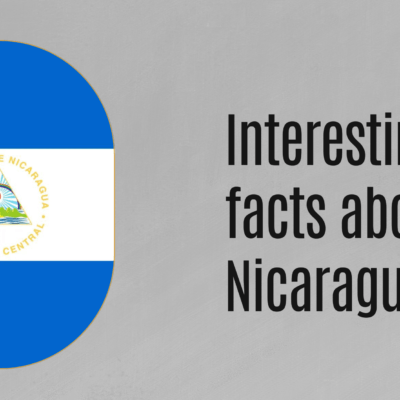Interesting facts about Nicaragua: Nicaragua is a country filled with glamorous and unique aspects that make it stand out among the nations of Central America. From its gorgeous landscapes to its rich cultural heritage, here are a few some interesting facts about Nicaragua:
Also Read:
- 16 interesting facts about April fools’ day.
- Liz Murray interesting facts.
- Interesting facts about George Orwell.
- 30 Interesting Hitler fun facts.
- Fascinating fact about Venezuela.
- Interesting facts about Paraguay.
Interesting facts about Nicaragua
- Nicaragua is the largest country in Central America, bordered by Honduras to the north and Costa Rica to the south.
- The official language of Nicaragua is Spanish.
- The capital city of Nicaragua is Managua, which is also the largest city in the country.
- Nicaragua has two coastlines, one on the Pacific Ocean and the other on the Caribbean Sea.
- Lake Nicaragua, also known as Cocibolca, is the largest lake in Central America and contains numerous small islands.
- The country is known for its volcanic landscape, with around 19 active volcanoes, including Momotombo and Concepción.
- Nicaragua is famous for producing high-quality coffee, which is one of its major exports.
- It is the only country in the world where freshwater sharks can be found, specifically in Lake Nicaragua.
- Nicaragua has a diverse range of ecosystems, from rainforests to dry forests and coastal mangroves.
- The national tree of Nicaragua is the madroño, known for its striking red bark.
- Corn is a staple food in Nicaraguan cuisine, and the country has many traditional corn-based dishes like gallo pinto.
- Baseball is the most popular sport in Nicaragua, and the country has produced several Major League Baseball players.
Nicaragua interesting facts
- Nicaragua has a rich cultural heritage, with strong influences from indigenous, Spanish, and Afro-Caribbean traditions.
- The country celebrates its Independence Day on September 15th, commemorating its independence from Spain in 1821.
- Ometepe Island, located in Lake Nicaragua, is the world’s largest volcanic island within a freshwater lake.
- Nicaragua is home to several indigenous communities, including the Miskito, Sumo, and Rama peoples.
- The annual “La Purísima” festival is a major religious celebration in Nicaragua, honoring the Immaculate Conception of the Virgin Mary.
- Nicaragua has a significant number of protected areas, including 78 natural reserves and wildlife refuges.
- The country’s currency is the Nicaraguan córdoba.
- Nicaragua’s official flower is the sacuanjoche, a fragrant white flower with a strong cultural significance.
Interesting facts about Nicaragua
- The musical instrument known as the marimba is widely used in traditional Nicaraguan music.
- Lake Nicaragua is home to the rare freshwater bull shark, which has adapted to live in both freshwater and saltwater environments.
- Nicaragua’s national dish is “gallo pinto,” a traditional combination of rice and beans often served with eggs and plantains.
- Nicaragua has two distinct seasons: the dry season from November to April and the rainy season from May to October.
- The country is known for its beautiful colonial cities, such as Granada and León, which are UNESCO World Heritage Sites.
- Nicaragua is one of the world’s top producers of rum, with brands like Flor de Caña gaining international recognition.
- The Rio San Juan is a major river in Nicaragua and served as a historic trade route between the Caribbean Sea and Lake Nicaragua.
- Nicaragua is a popular destination for eco-tourism, offering opportunities for hiking, birdwatching, and wildlife spotting.
- The annual “Gigantona” festival in Masaya features large papier-mâché figures dancing through the streets.
Nicaragua interesting facts
- Nicaragua is prone to earthquakes and volcanic eruptions due to its location along the Pacific Ring of Fire.
- The indigenous language Miskito is still widely spoken in the eastern regions of Nicaragua.
- The famous American writer Mark Twain once visited Nicaragua and described it as “the land of lakes and volcanoes.”
- The country’s national bird is the turquoise-browed motmot, known for its colorful plumage and distinctive call.
- Nicaragua has several beautiful beaches along its Pacific and Caribbean coasts, attracting surfers and beach enthusiasts.
- The famous poet Rubén Darío considered the father of modernism in Spanish literature, was Nicaraguan.
- Nicaragua is one of the poorest countries in the Americas, with a significant portion of the population living below the poverty line.
- The country’s cuisine is influenced by Spanish, Indigenous, and Afro-Caribbean flavors, creating a unique fusion of tastes.
- The annual “San Sebastián” festival in Diriamba is known for its lively parades and colorful traditional costumes.
- Nicaragua is home to a variety of unique wildlife, including jaguars, tapirs, and the endangered sea turtle species.
- Nicaragua’s diverse landscapes and rich cultural heritage make it a fascinating destination for travelers seeking adventure and cultural experiences.



